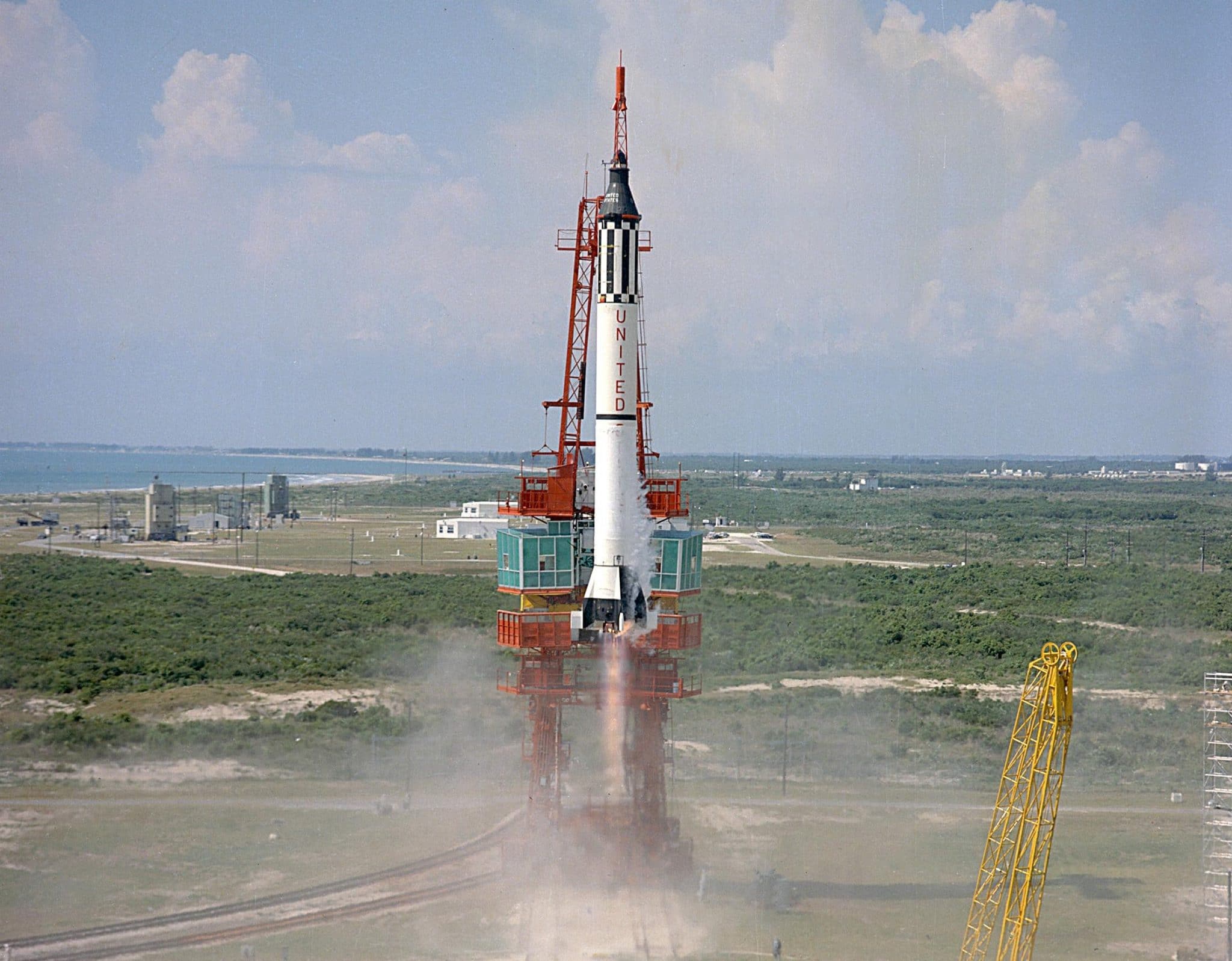How did the United States respond to the Soviet Union's early lead in the Space Race? On May 5, 1961, Alan Shepard became the first American to travel into space.

Alan Shepard Became NASA's First Astronaut in 1961 - Source avgeekery.com
Editor's Note: This "1961: Alan Shepard Becomes First American To Travel Into Space" guide was published today because it is an important topic to understand. NASA launched Freedom 7, carrying Shepard, a 37-year-old Navy pilot, on a suborbital flight that lasted just 15 minutes. Shepard's flight was a major milestone in the Space Race and helped to boost American morale.
To help our audience make the right decision, our team of experts has analyzed and researched a variety of sources, and we've put together this guide on "1961: Alan Shepard Becomes First American To Travel Into Space".
Key Differences or Key Takeaways
Here is a table summarizing the key differences or key takeaways from our research on "1961: Alan Shepard Becomes First American To Travel Into Space":
| Feature | 1961: Alan Shepard Becomes First American To Travel Into Space |
|---|---|
| Date | May 5, 1961 |
| Astronaut | Alan Shepard |
| Mission | Suborbital flight |
| Duration | 15 minutes |
| Significance | Major milestone in the Space Race |
Main Article Topics
The following are the main topics that we will cover in this guide on "1961: Alan Shepard Becomes First American To Travel Into Space":
- Background of the Space Race
- Alan Shepard's early life and career
- The Freedom 7 mission
- The significance of Shepard's flight
FAQ - 1961: Alan Shepard Becomes First American To Travel Into Space
Alan Shepard's historic spaceflight marked a pivotal moment in the US space race against the Soviet Union. Here are answers to frequently asked questions about this significant event:

Download wallpaper: Travel into space 1920x1200 - Source uhdwallpapers.org
Question 1: When and where did Alan Shepard's spaceflight take place?
Shepard's suborbital flight occurred on May 5, 1961, from Cape Canaveral, Florida.
Question 2: What was the name of the spacecraft Shepard flew in?
Shepard piloted the Freedom 7 spacecraft, designed and built by McDonnell Aircraft Corporation.
Question 3: How high did Shepard travel into space?
Shepard's spacecraft reached an altitude of approximately 116 miles (187 kilometers) above Earth.
Question 4: How long did Shepard's flight last?
Shepard's flight lasted approximately 15 minutes and 28 seconds from launch to splashdown.
Question 5: What were the key objectives of Shepard's mission?
The primary objectives were to demonstrate the feasibility of human spaceflight, evaluate Shepard's physical and mental capabilities in space, and gather scientific data on the Earth's atmosphere and ionosphere.
Question 6: What impact did Shepard's spaceflight have on the US space program?
Shepard's successful flight boosted US morale and confidence during the Cold War. It also provided valuable data and experience for subsequent space missions, including Project Mercury and the Apollo program.
The first American in space, Alan Shepard, paved the way for future generations of astronauts. His mission was a testament to the ingenuity, perseverance, and desire for knowledge that has fueled humanity's exploration of the cosmos.
Continue reading to learn more about the impact and significance of the space race.
Tips
On May 5, 1961, Alan Shepard became the first American to travel into space. 1961: Alan Shepard Becomes First American To Travel Into Space His historic flight marked a significant milestone in the United States' space program and inspired generations of astronauts and engineers. Here are some tips to learn from his successful mission.
Tip 1: Set Clear Goals
Before Shepard embarked on his mission, he had a clear objective: to become the first American to travel into space. Setting specific, measurable, achievable, relevant, and time-bound goals is crucial for success in any endeavor.

Missouri History Today May 5, 1961: Alan Shepard becomes the first - Source missourilife.com
Tip 2: Embrace Innovation
The Freedom 7 spacecraft that carried Shepard into space was a groundbreaking technological marvel. Embracing innovation and pushing the boundaries of technology are essential for making significant advancements.
Tip 3: Train Rigorously
Shepard underwent rigorous training before his flight, simulating every aspect of the mission. Thorough preparation and training enhance confidence and reduce the risk of errors.
Tip 4: Stay Focused
During his 15-minute flight, Shepard remained focused on his mission despite the intense pressure and distractions. Maintaining focus and staying composed under pressure is critical for achieving goals.
Tip 5: Persevere Through Obstacles
Shepard faced numerous challenges and setbacks during his training and the mission itself. Despite these obstacles, he persevered and never gave up. Resilience and perseverance are key qualities for overcoming adversity and achieving success.
Summary of key takeaways or benefits
Alan Shepard's historic mission serves as an inspiration and provides valuable lessons for success. By setting clear goals, embracing innovation, training rigorously, staying focused, and persevering through obstacles, individuals and teams can achieve extraordinary accomplishments.
Transition to the article's conclusion
The legacy of Alan Shepard's groundbreaking flight continues to inspire and guide generations of space explorers. May his example motivate us to strive for excellence, embrace challenges, and reach new heights.
1961: Alan Shepard Becomes First American To Travel Into Space
Alan Shepard's historic flight marked a pivotal moment in space exploration, showcasing the technological prowess of the United States and paving the way for future human missions into space.
- First American in Space: Shepard's pioneering journey made him a national hero and symbol of American innovation.
- Suborbital Flight: His spacecraft, Freedom 7, traveled to an altitude of 116 miles, reaching suborbital space.
- Fifteen-minute Mission: Shepard's flight lasted approximately 15 minutes, demonstrating the feasibility of human space travel.
- Mercury Program: His mission was part of NASA's Mercury program, which aimed to put the first Americans into space.
- Space Race: Shepard's flight occurred during the height of the Cold War, fueling the competition between the US and USSR.
- Legacy and Impact: His journey inspired generations of astronauts and scientists, and laid the groundwork for future space exploration missions.
Shepard's flight not only achieved a milestone in human space travel but also had far-reaching implications for scientific research, global cooperation, and the advancement of human knowledge.
#OnThisDay in 1961, Alan Shepard... - U.S. EMBASSY ATHENS - Source www.facebook.com
1961: Alan Shepard Becomes First American To Travel Into Space
The successful mission of Alan Shepard, the first American to travel into space, was a pivotal moment in the history of space exploration. Shepard's flight paved the way for subsequent space missions, including the Apollo program that would eventually put humans on the moon. The development of the Mercury spacecraft and the training of Shepard and his fellow astronauts demonstrated the United States' commitment to space exploration. The mission also inspired future generations of scientists and engineers, leading to advancements in technology and our understanding of the cosmos.
On this day in 1961,... - Astronaut Scholarship Foundation | Facebook - Source www.facebook.com
Shepard's flight was the culmination of years of research and development by NASA. The Mercury spacecraft was designed to carry a single astronaut into orbit around the Earth. Shepard was selected for the mission due to his experience as a naval aviator and his calm demeanor under pressure. The mission was launched from Cape Canaveral, Florida, on May 5, 1961. Shepard's spacecraft, Freedom 7, reached an altitude of 116 miles (187 kilometers) and completed one orbit of the Earth. The flight lasted for 15 minutes and 28 seconds.
The success of Shepard's mission was a major victory for the United States in the Cold War space race with the Soviet Union. The Soviets had launched the first satellite, Sputnik 1, into orbit in 1957, and had sent the first man into space, Yuri Gagarin, in 1961. Shepard's flight showed that the United States was capable of matching the Soviet Union's achievements in space.
Shepard's mission also had a profound impact on the United States' space program. The success of the Mercury program led to the development of the Apollo program, which would eventually put humans on the moon. Shepard himself would go on to command the Apollo 14 mission, which landed on the moon in 1971.
Conclusion
Alan Shepard's historic flight was a testament to the ingenuity and determination of the American people. His mission paved the way for future space exploration and inspired generations of scientists and engineers. It is a reminder of the power of human ambition and the importance of setting our sights on the stars.
The legacy of Alan Shepard's flight continues to inspire us today. It is a reminder that anything is possible if we dare to dream and work hard to achieve our goals. It is also a reminder that we are all connected to the stars, and that we are capable of great things if we work together.

